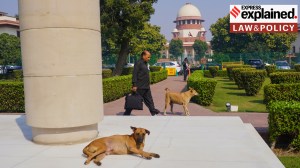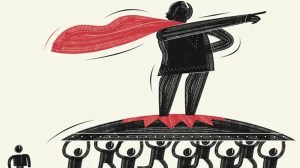Poised for the jump
US President Nixon transformed US relations with China with his breakthrough trip to China. This led after a decade or so to a transformatio...

US President Nixon transformed US relations with China with his breakthrough trip to China. This led after a decade or so to a transformation of China’s role in Asia. President Reagan transformed US relations with the USSR, contributing to the disintegration of the Soviet empire. Will President Bush transform US relationship with India leading to a transformation of India’s role in Asia? A change in objective conditions suggests this is likely. There are, however, obstacles on the US side that will have to be overcome.
President Clinton, after his statement about China and the US being strategic partners and jointly deploring India’s 1998 nuclear tests, repaired relations by condemning Pakistani aggression in Kargil and supporting the Strobe Talbot-Jaswant Singh talks. These talks, along with candidate Bush’s advisory group, ‘‘Vulcans’’, that included Condoleezza Rice and Robert Blackwill, laid the foundation for a changed approach of the US towards India. President Bush envisaged a much bigger role to India in global affairs than his predecessors. PM Vajpayee reciprocated by calling India and the US “natural allies.” This resulted in the initiative, Next Steps in Strategic & Technological Partnership (NSSTP). The process was, however, sidetracked by 9/11 as the US focus shifted to Afghanistan and Iraq and Pakistan made itself indispensable to the US.
The transformation had, therefore, to await President Bush’s second term and the visit of Secretary Rice to India in March 2005 followed by the background briefing recognising India’s potential power. A major landmark will be PM Manmohan Singh’s visit to Washington this month. A key test will be US support for a permanent UNSC seat. A possible deliverable is the formation of an India-US study group for a CECA. The transformation will likely (with 75 per cent probability) be in place by the time President Bush visits India at the end of 2005-6, with the key test being an agreement to free the flow of nuclear plants and materials from the US to India.
The global economy is undergoing a dramatic transformation. Over the next 35 years both the Chinese and Indian economies will become larger than the US economy in size (measured in PPP). In the case of China this will happen in a decade while in India it will take an additional 25 years. At the same time Japan’s economy will decline gradually and Russia’s will rise slowly (relative to the US) as the population of both declines by 25 per cent over the next 50 years. The large economies of Europe will see varying population declines that will reduce their GDP relative to the US.
The impact on the global balance of power will be equally dramatic. This is shown by the ‘‘Index of Power Potential’’ based on economic projections. Currently the US is the strongest power by a wide margin and the world is correctly described as unipolar — constraints imposed by terrorists, jehadis and rogue states notwithstanding. With the rise of China and India the world will become bi-polar by 2025 and tri-polar by 2050. This poses a serious challenge to the global order in general and to the US in particular.
Historically, the rise of a new power has invariably led to conflict with the established power. This suggests that China will very likely challenge US power in Asia during the next 20 years and conflict between the two on Taiwan cannot be ruled out. If the US withdraws from Asia then the imbalance of power will put great pressure on the freedom and independence of China’s neighbours in Asia. There is one exception to the generalisation of inevitable conflict between the incumbent and the challenger. The declining colonial power, Britain, gradually ceded power to the rising US in the late 19th and early 20th century. There are several differences between that situation and the one that obtains today. Firstly, both the US and UK were English speaking democracies with a large cultural and philosophical overlap. This is not true of China and the US. Second, China considers Taiwan, parts of North India, the South China Sea and other areas as wrongfully taken from it. It has historical grievances against Japan that persist to this day. Unless these issues are resolved peacefully they retain the potential for igniting conflict. Third, the degree of globalisation and economic interdependence is much higher now. A fourth factor is the existence of nuclear weapons and their deterrent effect. The first two factors suggest that US-China conflict is more likely and the next two that it is less likely than in the US-UK case.
In either case, the balance of power in Asia will be critical to peace in Asia and India’s power potential will be greater than Japan’s and Russia’s by 2025. A natural balance of power, in which India and China (with equal population in 2030) have similar levels of per capita GDP will make peaceful evolution of global relations more likely. This requires an expeditious closing of the technological and economic gap between India and China. The recognition of this fact by President Bush and his advisors is the key factor underlying the transformation of US-India relations. The fact that the US and India share fundamental human and democratic values provides a basis for mutual trust.
From India’s perspective the key to a US-India partnership is technology transfer and technological co-operation. This requires an exemption of India from the denial regime set up by the US and its allies after India’s 1974 atomic test, which played a role in the opening of the China-India GDP gap. India must get civilian nuclear technology on conditions no more stringent than China. President Bush’s past actions suggest he has the guts to change a dysfunctional regime that allowed NPT members to transfer weapons designs and/or technology to Pakistan, Libya, N. Korea and Iran while stopping supply of nuclear fuel to India’s power stations.
The Indian public seems to sense this possibility. That is why global polls show Indians giving the US and its president the highest positive ratings among all countries. Indians are well aware of the US blind eye towards Pakistan military/ISI’s sheltering of Taliban and Al Qaeda leaders and training and financing of anti-India terrorists. But they hope that, despite the large current asymmetry in GDP and power, President Bush can transform India-US relations in order to bring equal benefits to both.
The writer is director and CE, ICRIER. The views expressed here are personal



- 01
- 02
- 03
- 04
- 05




























